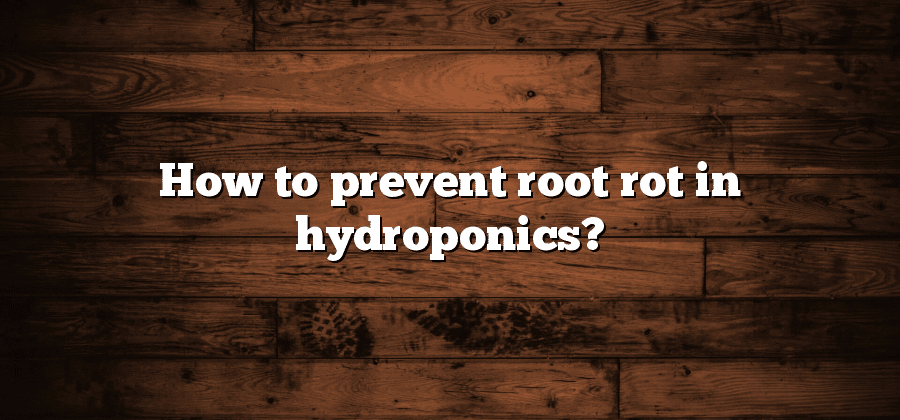Causes of root rot in hydroponics
Excessive moisture and poor oxygenation are common causes of root rot in hydroponics. When the growing medium retains too much water, it creates a conducive environment for harmful pathogens, such as Pythium or Fusarium, to thrive. These pathogens attack the root system and disrupt the plant’s ability to absorb nutrients and water, ultimately leading to root rot. Additionally, inadequate oxygen levels in the root zone impede the plants’ ability to respire properly, resulting in anaerobic conditions that encourage the growth of root rot-causing pathogens. Proper understanding and management of these factors are crucial in preventing root rot and ensuring the health of hydroponic plants.
The choice of growing medium also plays a pivotal role in the occurrence of root rot. Organic materials like soil or peat moss tend to retain excessive moisture, promoting the growth of harmful pathogens. In contrast, inert media such as perlite, rockwool, or coco coir offer better drainage and aeration, reducing the likelihood of root rot. It is essential to select a growing medium that allows for sufficient water retention and drainage to strike the right balance for the plants’ root health.
Symptoms of root rot in hydroponics
Symptoms of root rot in hydroponics can be easily identified if one knows what to look out for. The first indication may be a foul odor emanating from the root system. As root rot progresses, the roots may become mushy and discolored, turning brown or even black. Additionally, affected plants may exhibit stunted growth, wilting leaves, and yellowing foliage. These symptoms are a result of the roots being unable to absorb water and nutrients effectively, leading to nutrient deficiencies and poor overall plant health.
Another symptom to watch out for is the presence of slimy or slimy-looking roots and root tips. This slimy texture is often caused by the growth of bacteria and fungi that thrive in oxygen-deprived environments. In severe cases, these pathogens may even form a fungus-like layer on the roots, further inhibiting the plants’ ability to absorb nutrients. It’s important to note that while these symptoms can be indicative of root rot, they can also be caused by other issues such as nutrient imbalances or overwatering. Therefore, it’s crucial to thoroughly assess the root system and take proactive steps to address and prevent root rot.
Choosing the right growing medium
Hydroponics, a method of growing plants without soil, offers numerous benefits such as increased productivity and resource efficiency. When it comes to choosing the right growing medium for your hydroponic system, several factors should be considered. Firstly, the medium should provide sufficient support for the plants’ root systems, allowing them to anchor securely and access the necessary nutrients. Additionally, the growing medium should have excellent water retention properties while still allowing for adequate drainage to prevent waterlogging. It is also crucial to select a medium that is sterile and free from pathogens to minimize the risk of root rot and other diseases.
Different types of growing mediums are available for hydroponics, including perlite, coco coir, expanded clay pellets, and rockwool. Each medium has its own unique set of characteristics and pros and cons. For instance, perlite is lightweight, porous, and holds water well, making it suitable for plants that prefer a well-drained environment. On the other hand, coco coir has excellent water retention abilities and provides a stable pH environment for the roots. Expanded clay pellets are lightweight and provide ample oxygenation, promoting healthy root growth. Rockwool, made from spinning molten basaltic rock, offers good water absorption and drainage properties.
In conclusion, selecting the appropriate growing medium is a critical step in hydroponic gardening. Careful consideration of factors such as support, water retention, drainage, and sterility will contribute to the success of your hydroponic system. By understanding the characteristics and benefits of different growing mediums, you can make an informed decision that best suits your plants’ needs and ensures optimal growth and health. Remember to regularly monitor and maintain the condition of your growing medium to prevent any issues such as root rot and maximize the potential of your hydroponic garden.
Maintaining proper oxygen levels
One critical factor to consider in hydroponics is maintaining proper oxygen levels. Adequate oxygen is vital for the health and growth of plant roots in a hydroponic system. Insufficient oxygen can lead to root rot and other diseases, hampering the overall success of your hydroponic endeavor.
To ensure optimal oxygen levels, it is essential to have proper aeration in your system. This can be achieved through the use of air pumps and air stones or diffusers. These tools help to oxygenate the water, ensuring that your plants receive the necessary oxygen they need. Regularly monitoring and adjusting the oxygen levels in your hydroponic system is crucial to maintain healthy roots and promote robust plant growth.
Implementing a sterilization routine
Hydroponic systems provide an ideal environment for plant growth, free from soil-borne diseases and pests. However, the absence of soil does not eliminate the risk of root rot. In fact, root rot can still occur in hydroponics due to the presence of pathogens and other contaminants. To mitigate this risk, it is essential to implement a sterilization routine.
Keeping a sterilization routine is crucial in maintaining a clean and disease-free hydroponic system. By regularly sterilizing all equipment, including trays, pots, and tools, you can eliminate any potential pathogens that may be present. Sterilization can be done using a variety of methods such as heat treatment, chemical disinfection, or even exposure to ultraviolet light. It is important to choose a method that is effective in killing pathogens but does not harm the plants. A strict sterilization routine can significantly reduce the chances of root rot and ensure healthy plant growth in your hydroponic system.






